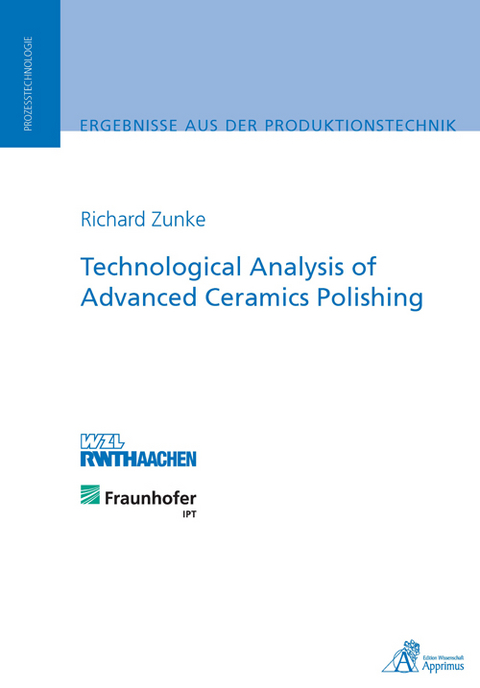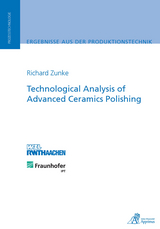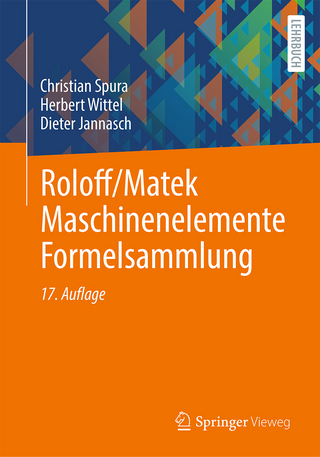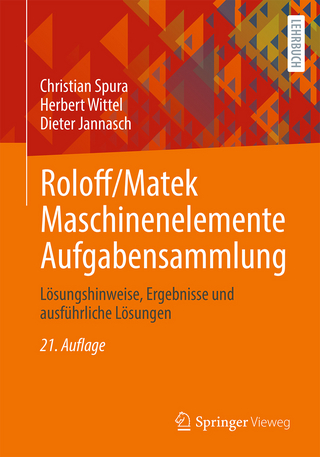Technological Analysis of Advanced Ceramics Polishing
Seiten
- Titel nicht im Sortiment
- Artikel merken
The technological analysis contributes to the understanding of the polishing behaviour of advanced ceramics. Alumina, silicon carbide, silicon nitride, and zirconia are polished to identify material specific influences on the process and its outcome. The investigations follow the common goals of polishing processes: low roughness, high removal rates, and defect-free surfaces. The phenomenological approach is based on the hypothesis that polishing can be modelled as a tribological system. Thus, removal mechanisms in polishing are analysed in accordance to wear mechanisms and the respective models originating from wear theory. On the one hand, diamond slurry is used to investigate the significant process interactions of advanced ceramics polishing. On the other hand, soft polishing agents, i.e., ceria and zirconia, are employed to polish silicon nitride. Both investigations are designed to follow an analogous procedure. First, an evaluation of stability and reproducibility of the removal rate is given. Second, an analysis based on online monitored data, e.g., polishing power, process energy, slurry pH, and temperature is provided. Third, the resulting surface quality is quantitatively and qualitatively examined. Fourth, the resulting boundary layers are inspected to determine mechanical and chemical interactions. The polishing experiments with diamond slurry proved that mechanical interactions dominate the material removal. The findings represent both a broad overview due to the wide range of polished ceramics but also a detailed analysis on the nano- and microscale due to the employed advanced analytical methods, e.g., scanning and transmission electron microscopy. The diverse results are explained based on the material specific characteristics determining the resulting removal mechanisms. According to the state-of-the-art, polishing of silicon nitride with ceria and zirconia slurries benefits from a synergy of mechanical and chemical interactions, whereas the published explanations of process interactions are partially contradicting. Therefore, the experiments are designed to clarify the validity of the various hypotheses. The investigation concludes with a new model elucidating the responsible mechanochemical interactions. Contrary to polishing with diamond slurry and to Preston's hypothesis, the influence of pressure is more significant than relative velocity. The achievable roughness values of the defect-free surfaces are as low as Sa ~2 nm and Sz ~20 nm.
The technological analysis contributes to the understanding of the polishing behaviour of advanced ceramics. Alumina, silicon carbide, silicon nitride, and zirconia are polished to identify material specific influences on the process and its outcome. The investigations follow the common goals of polishing processes: low roughness, high removal rates, and defect-free surfaces. The phenomenological approach is based on the hypothesis that polishing can be modelled as a tribological system. Thus, removal mechanisms in polishing are analysed in accordance to wear mechanisms and the respective models originating from wear theory. On the one hand, diamond slurry is used to investigate the significant process interactions of advanced ceramics polishing. On the other hand, soft polishing agents, i.e., ceria and zirconia, are employed to polish silicon nitride. Both investigations are designed to follow an analogous procedure. First, an evaluation of stability and reproducibility of the removal rate is given. Second, an analysis based on online monitored data, e.g., polishing power, process energy, slurry pH, and temperature is provided. Third, the resulting surface quality is quantitatively and qualitatively examined. Fourth, the resulting boundary layers are inspected to determine mechanical and chemical interactions. The polishing experiments with diamond slurry proved that mechanical interactions dominate the material removal. The findings represent both a broad overview due to the wide range of polished ceramics but also a detailed analysis on the nano- and microscale due to the employed advanced analytical methods, e.g., scanning and transmission electron microscopy. The diverse results are explained based on the material specific characteristics determining the resulting removal mechanisms. According to the state-of-the-art, polishing of silicon nitride with ceria and zirconia slurries benefits from a synergy of mechanical and chemical interactions, whereas the published explanations of process interactions are partially contradicting. Therefore, the experiments are designed to clarify the validity of the various hypotheses. The investigation concludes with a new model elucidating the responsible mechanochemical interactions. Contrary to polishing with diamond slurry and to Preston’s hypothesis, the influence of pressure is more significant than relative velocity. The achievable roughness values of the defect-free surfaces are as low as Sa ~2 nm and Sz ~20 nm.
The technological analysis contributes to the understanding of the polishing behaviour of advanced ceramics. Alumina, silicon carbide, silicon nitride, and zirconia are polished to identify material specific influences on the process and its outcome. The investigations follow the common goals of polishing processes: low roughness, high removal rates, and defect-free surfaces. The phenomenological approach is based on the hypothesis that polishing can be modelled as a tribological system. Thus, removal mechanisms in polishing are analysed in accordance to wear mechanisms and the respective models originating from wear theory. On the one hand, diamond slurry is used to investigate the significant process interactions of advanced ceramics polishing. On the other hand, soft polishing agents, i.e., ceria and zirconia, are employed to polish silicon nitride. Both investigations are designed to follow an analogous procedure. First, an evaluation of stability and reproducibility of the removal rate is given. Second, an analysis based on online monitored data, e.g., polishing power, process energy, slurry pH, and temperature is provided. Third, the resulting surface quality is quantitatively and qualitatively examined. Fourth, the resulting boundary layers are inspected to determine mechanical and chemical interactions. The polishing experiments with diamond slurry proved that mechanical interactions dominate the material removal. The findings represent both a broad overview due to the wide range of polished ceramics but also a detailed analysis on the nano- and microscale due to the employed advanced analytical methods, e.g., scanning and transmission electron microscopy. The diverse results are explained based on the material specific characteristics determining the resulting removal mechanisms. According to the state-of-the-art, polishing of silicon nitride with ceria and zirconia slurries benefits from a synergy of mechanical and chemical interactions, whereas the published explanations of process interactions are partially contradicting. Therefore, the experiments are designed to clarify the validity of the various hypotheses. The investigation concludes with a new model elucidating the responsible mechanochemical interactions. Contrary to polishing with diamond slurry and to Preston’s hypothesis, the influence of pressure is more significant than relative velocity. The achievable roughness values of the defect-free surfaces are as low as Sa ~2 nm and Sz ~20 nm.
| Erscheint lt. Verlag | 22.12.2011 |
|---|---|
| Sprache | englisch |
| Maße | 148 x 210 mm |
| Gewicht | 295 g |
| Einbandart | Paperback |
| Themenwelt | Technik ► Maschinenbau |
| Schlagworte | Abtragen • Fertigungstechnik • Keramik • Polieren • Überwachen |
| ISBN-10 | 3-86359-048-1 / 3863590481 |
| ISBN-13 | 978-3-86359-048-2 / 9783863590482 |
| Zustand | Neuware |
| Haben Sie eine Frage zum Produkt? |
Mehr entdecken
aus dem Bereich
aus dem Bereich
Buch | Softcover (2023)
Springer Vieweg (Verlag)
24,99 €
Normung, Berechnung, Gestaltung
Buch | Softcover (2023)
Springer Vieweg (Verlag)
39,99 €
Lösungshinweise, Ergebnisse und ausführliche Lösungen
Buch | Softcover (2023)
Springer Vieweg (Verlag)
26,99 €




